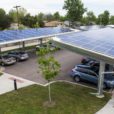by MARIA VIRGINIA OLANO POLICY AND RESEARCH FELLOW
President Trump released the full text of his infrastructure proposal to congress on Monday, in a plan that aims to ‘stimulate’ $1.5 trillion in new investment over the next ten years to revamp American infrastructure while only allocating $200 billion from federal funds. There is a big emphasis on privatization and the use of private funds in order to achieve its ambitious goals; the plan also relies heavily on state and local funds while limit the amount of federal dollars devoted to the various projects outlined. Elements of the proposal include the expanded use of tax-exempt debt, making it easier to lease public assets and let states add tolls on highways to generate funds. The plan also aims to “shorten the process for approving projects to 2 years or less, address unmet rural infrastructure needs, empower State and local authorities, and train the American workforce of the future.”
And despite its outlook, absent in the 55 page document is climate change, or an acknowledgement of the risks associated with it as they pertain to infrastructure, even though considerations of climate-related threats will undoubtedly need to be considered in future infrastructure planning. There is serious concern that ignoring climate-related threats from the outset of projects could mean costly investments may be vulnerable to damage or even worse, be rendered obsolete by a changed environment. Climate change already poses significant threats to our existing infrastructure. A 2017 report by the EPA concluded that up to $280 billion will be needed by the end of the century to adapt the nation’s roads and railways to the effects of a warming climate and repair damage from it. It makes little sense then to focus on investing billions without safeguarding from spending needed to protect those investments in the near future. Any infrastructure plan should include proactive adaptation, meaning, planning for the effects of global warming before construction to ensure resilient and cost-effective infrastructure.
There are also some worrying present-time elements of the proposed plan, specifically as it relates to environmental protection and transportation.
Environmental Protection
The proposed framework also devotes a significant section to changing the federal environmental review process, which the administration says is “fragmented, inefficient and unpredictable.” It proposes putting a single agency in charge of environmental reviews and would impose a 21-month deadline for assessments of projects that would potentially threaten fragile habitats and endangered species as well as protected lands. The White House wants to also give the Interior Department authority to approve oil and gas pipelines that cross lands controlled by the National Park Service. Currently, those approvals are under Congressional purview, which the administration says is time consuming and results in delays. If approved, this would be a concerning development in stripping decades of institutional reviews designed to protect the most important environmental resources and safeguard species conservation.
Transportation
President Trump’s plan for transportation is largely focused on building new roads, highways and bridges. He has even proposed to allow states to put up tolls and charge more fees for using roads. It is a shame that the President sees this as a viable option over carbon pricing, which could also free up cash for new infrastructure development.
The larger looming question that remains is whether this administration is truly looking towards the future and ensuring America remains globally competitive. Like many of Trump’s policies, this infrastructure plan seems to resort to 20th century solutions for 21st century problems and the whole proposal seems to truly miss an opportunity to build infrastructure for the future. We should not be focusing on optimizing infrastructure for personal vehicle use, but rather investing in larger, more efficient, and faster public transportation – not just within cities but across the United States. Donald Trump has countlessly compared America’s aging infrastructure to that of Japan, Germany and the Netherlands, arguing that America too, should have such impressive transport systems and urban planning. What he has missed however, is the fact that all of these countries have optimized spending around future needs as well as future threats with electrification of transportation and the inclusion of alternative energy sources at the center of their investments. Renewable power, high-speed rail, smart grids, electric vehicles and electrified public transport are all key infrastructure points for increased competition and higher resiliency in the 21st century, none of which get a single mention in the White House’s infrastructure plan.
 MARIA VIRGINIA OLANO POLICY AND RESEARCH FELLOW
MARIA VIRGINIA OLANO POLICY AND RESEARCH FELLOW
Maria Virginia is a young professional with experience in non-profit and coalition organizing in the areas of disarmament and human rights. She is currently pursing a Masters degree in Security and Resilience Policy at Northeastern University, where she also completed her undergraduate degree in Political Science. During her time at Northeastern she studied abroad in Japan, India and Saudi Arabia and worked as a journalism intern in Bosnia Herzegovina and Turkey. She is passionate about travel and photography and in her free time loves to watch movies, eat lots of food and read.










